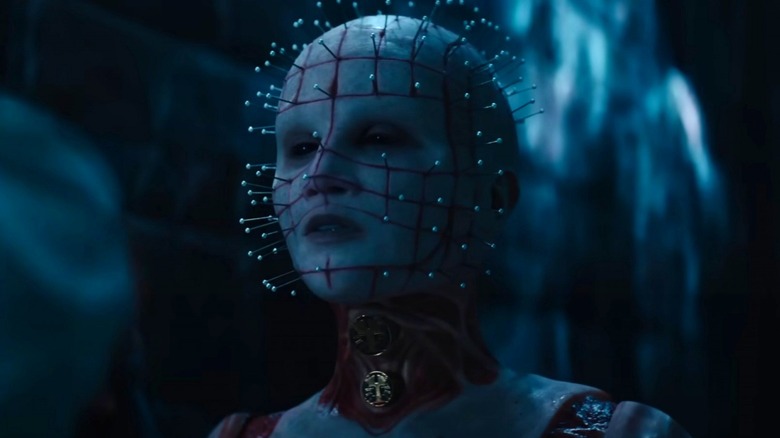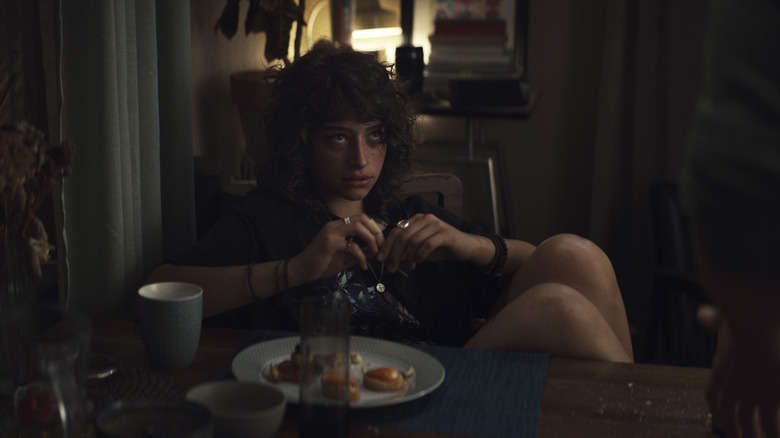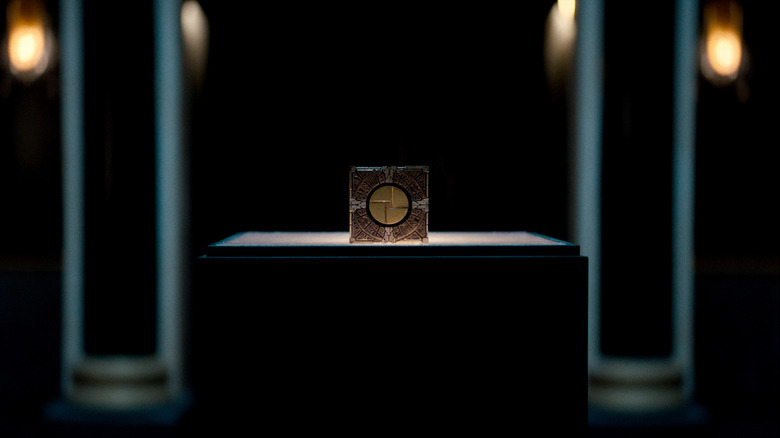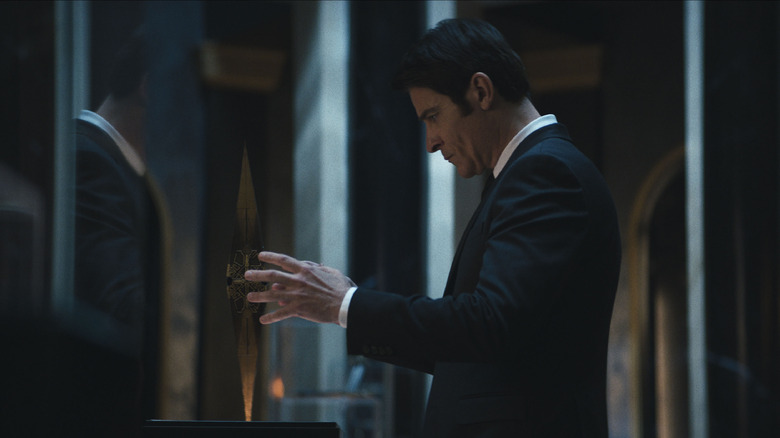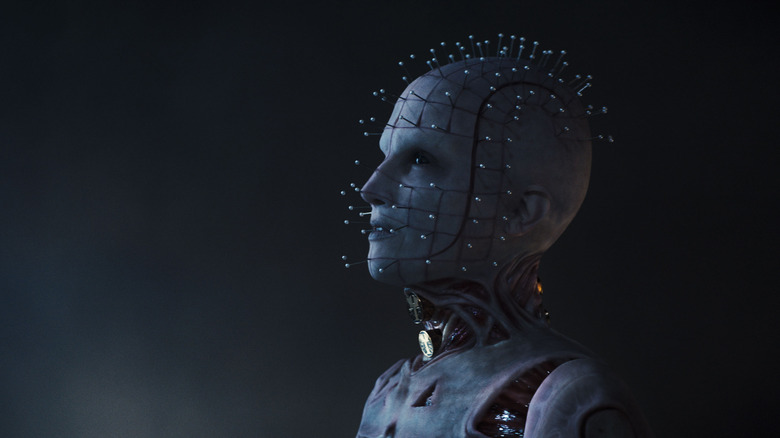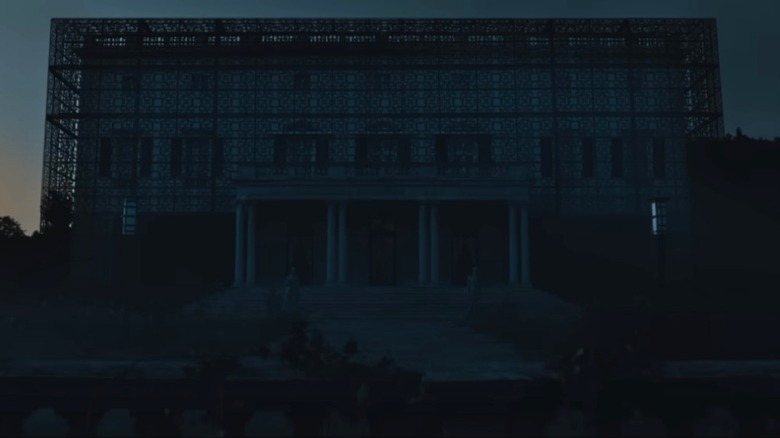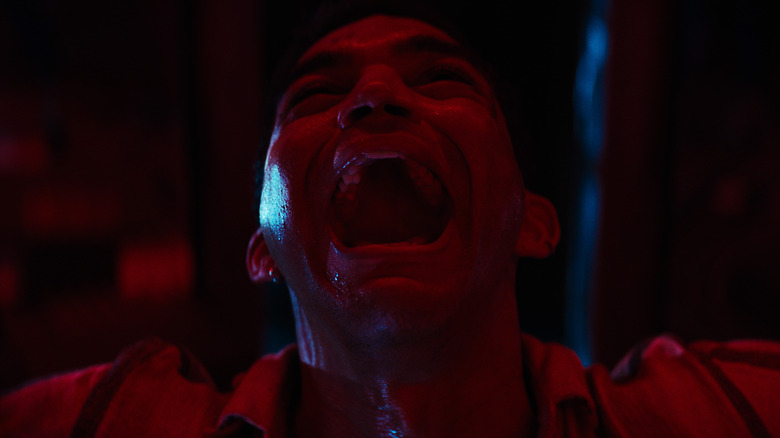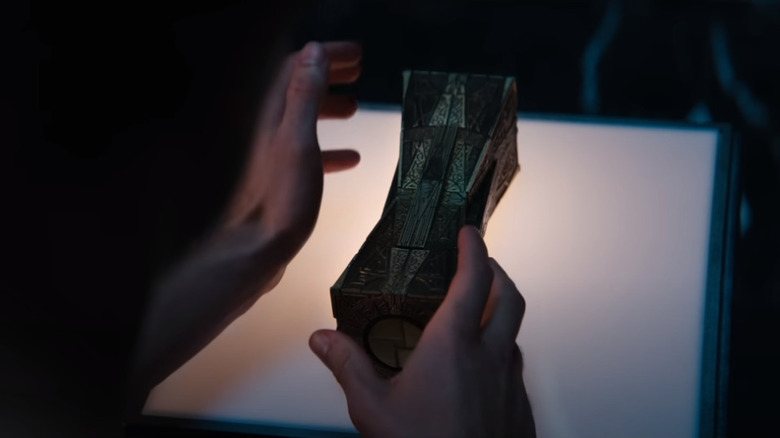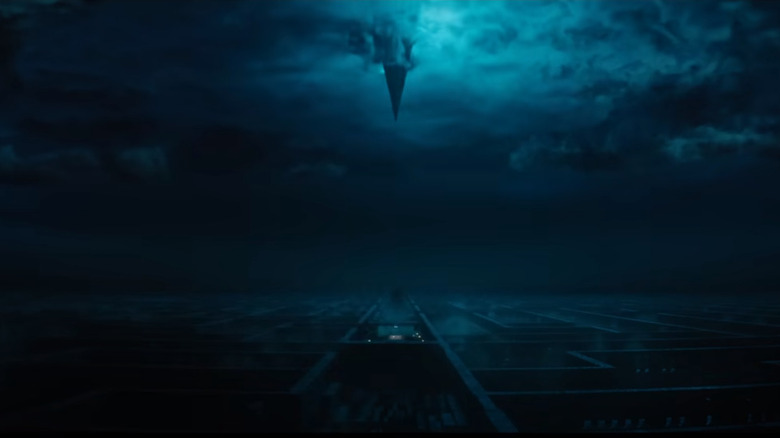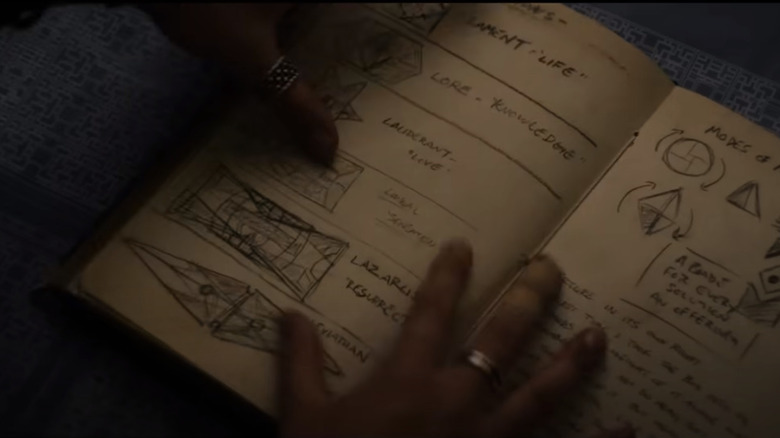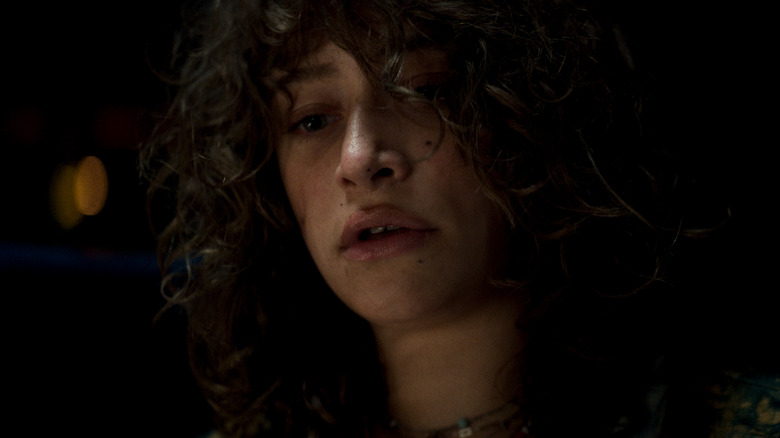The Ending Of Hulu's Hellraiser Explained
Contains spoilers for "Hellraiser" (2022).
In 2022, four years after the last film in the franchise, "Hellraiser" got a new lease on life with a reimagined look at the mythology through the eyes of filmmaker David Bruckner, fresh off his horror triumph "The Night House." With the help of screenwriters Ben Collins and Luke Piotrowski and based on the original stories by Clive Barker, Bruckner created a new version of the "Hellraiser" world that includes a redesigned puzzle box, a new cast of human characters, and of course, a new version of the Hell Priest known as "Pinhead," played by Jamie Clayton.
But the 2022 "Hellraiser" film is about more than some cool new visuals. The film also reimagines the entire scope of the lore surrounding the demonic entities known as the Cenobites and the elaborate puzzle box used to summon them. In offering even more layers to the mythos, "Hellraiser" 2022 also opens up many more possibilities for the franchise, within this single film and within potential sequels. So let's break down these possibilities through the context of the film's ending, examining the characters, the lore, and the implications of what could come next. This is the ending of "Hellraiser" explained.
Riley's journey
The best stories in the "Hellraiser" universe are always exploring how far a particular person will go to get what they want. In the case of the 2022 film, that question extends to two different people: Riley (Odessa A'zon) and Mr. Voight (Goran Visnjic). They both come to the legendary puzzle box through entirely different circumstances, desiring entirely different things, and reaching entirely different conclusions, but for most of the film, it's Riley's journey that takes center stage.
Riley finds the box amid a struggle with addiction and directionless living, hoping that the potential riches the object might bring will turn her life around in some way or another. What she finds instead is pain and untold horror, as she loses her brother and finds herself at the center of a vast, terrifying secret from which she may never be able to escape. By the end of the film, with the secrets of the box and the Cenobites it unleashes laid bare, she has learned that this journey offers no easy answers and no magical solutions. All she can do, the box teaches her, is surrender to its power or carve a path forward by herself. She chooses the latter, to the Cenobites' dismay, and in the process grows as a person, realizing that she must face her pain rather than attempt to circumvent or transform it. It's a difficult choice, but it's the one that seemingly leaves Riley free to live life on her terms.
The box's future
As Riley discovers when she stumbles upon Voight's research, the puzzle box — called the Lament Configuration in the previous entries in the franchise — at the heart of the story has a long, strange history. Much like the box from the original "Hellraiser," it has a mythology built up behind it based on decades of people seeking its wonders, but unlike that box, it has extra layers to its various configurations. There are six in total, yielding different gifts based on the solution. By delivering blood and souls to this version of the box, the user can reach new levels of experience and even choose their fate when reaching the Cenobites' god, Leviathan, and the Cenobites with the final of five configurations.
This adds a certain depth to the story of the box, which is particularly clear when Riley discovers that Voight survived his encounter with the artifact, though he was transformed into a being in constant pain by the Cenobites. This suggests that more than one person who has, in some form, lived to tell the tale of the box and their adventures with it, and if the right person picks up that trail, they just might find a trove of new information.
Riley leaves the box behind, suggesting she's not the person to keep investigating its secrets, but that doesn't mean the box will be abandoned forever. If we've learned anything from this franchise so far, someone else is bound to grow curious, activate the box, and search for new truths about its history. What they find, and how it changes them, seems like perfect fodder for a sequel.
Voight the Cenobite
Because Voight survived his encounter with Leviathan at the end of his first journey with the puzzle box, he is able to impart certain information about what the Cenobites are and what they really want. As he explains to Riley, every choice the beings present to the user of the box is a "trick," a doorway to some untold pain that varies based on the user but nevertheless always comes back to suffering.
In his quest to give back his gift — the Liminal Configuration, which pushes his nerve endings to maximum pain at every opportunity — Voight puts more and more people in harm's way, only to be told at the end by the Hell Priest that there is "no retreat once a threshold has been crossed." All he can do is make an exchange.
At the Hell Priest's behest, he chooses the Leviathan Configuration, granting him the power that his true nature was always seeking. What he doesn't know, and what the last scene reveals, is that this means he will become a Cenobite in service to the constant pursuit of "anguish." The film leaves us without a clear picture of Voight's Cenobite future, but it seems quite possible that a sequel would see him standing side-by-side with the Hell Priest, working the dark magic of the Cenobites on others. What this means for his human form, his memories, and other aspects of the man he was, remains to be seen.
The Hell Priest's secrets
As with the original "Hellraiser," we're introduced to the lead Cenobite — popularly known as "Pinhead" and known in this film as the Hell Priest — primarily through their actions. They are there to simply fulfill their role as servants of the puzzle box and not to provide much in the way of their own backstory. Most of what we know about the character is about their role in this story, not how they became what they are, or why, or how long they've been serving this particular order of strange beings.
But that doesn't mean the Hell Priest is without personality over the course of 2022's "Hellraiser." At least twice in the film, we see them react with surprise, amusement, or both, as their order is challenged by both Voight and Riley in different ways. This suggests that the Hell Priest, like their predecessor, is not immune to bargains, compromises, or simply intriguing new configurations of the order they've established. With all that in mind, we're left by the end of the film to wonder: What does that mean for potential sequels?
With any luck, future films would grant us a more personal, detailed look at who and what the Hell Priest is — much as "Hellbound: Hellraiser II" does — and what led them to choose the Leviathan Configuration and ultimately become a Cenobite. In the process, we might learn what continues to drive them and what, if anything, they hope to gain from continuing to fulfill this role for all eternity.
The secrets of Voight's house
As "Hellraiser" goes on, we get more and more insights into Voight and his years-long search for the furthest reaches of human experience, which included turning his mansion into not just a museum, but an elaborate puzzle box of sorts in and of itself. It's a home filled with secret rooms, artifacts, and automated features, including a complex metal cage that descends over the entire structure with the flick of a few switches. Eventually, it's revealed that the cage was designed by Voight specifically to trap the Cenobites in place, allowing him to demand they remove his "Liminal" gift and free him from his life of constant pain.
Of course, the outside world doesn't know this, or at least they don't know it yet. Whether Riley tells someone or various authorities eventually get curious, though, someone is going to make their way out to Voight's mansion again at some point, and they're going to find a chamber of horrors that likely includes the puzzle box, still on the floor where Riley chose to leave it. What that means for the future of the box isn't clear, but it's likely someone, somewhere, knows exactly what it is, and what to do with it. If we've learned anything from "Hellraiser" films, it's that these sorts of hidden places never stay hidden long, because the human pursuit of desires never ceases.
Colin's future
Almost everyone connected to the saga of the puzzle box in David Bruckner's "Hellraiser" dies, one way or another, but Riley's not the only survivor of this particular story. Colin (Adam Faison), devoted partner to Riley's dead brother (Brandon Flynn) and devoted friend to Riley herself, also manages to survive thanks to Riley's last-second decision to leave Trevor (Drew Starkey) to the Cenobites rather than let Colin die. Colin's not a major decision-maker in this story, at least not in terms of the major moves regarding the box and the Cenobites, but he did have a crucial role to play. Now, like Riley, he has to get on with his life.
But what does that life look like now that Riley has seen these horrors, horrors that he's clearly not intrigued by in the same way other characters are but which will remain imprinted on his brain nevertheless? It seems likely based on the end of the film that he'll stay at least somewhat close to Riley, but as Riley attempts to go back out and live a regular life with her difficult history, what does that mean for Colin? Will he become the supportive platonic partner or will he be able to find love again? Does he have the horrible distinction, like Voight's former associate (Haim Abbas), of being cursed by the very contact he had with the box? It's not clear, but the road forward for a guy who's been through this much won't be easy.
Secrets of the box
Though it delves into the secret of the puzzle box more than any other single previous "Hellraiser" installment, laying out the complex lore surrounding this version of the artifact, the new "Hellraiser" film still leaves numerous questions about the box and its magical properties unanswered. Yes, we know what it does now and how it basically works, but there are so many other wrinkles that future films could explore, so many dark angles within its various configurations.
For one thing, are we sure this is the only box of its kind in existence? The film sets up a world in which a billionaire obsessed with the furthest reaches of experience does everything he can to acquire and then manipulate the box, so why couldn't other sinister individuals be doing the same thing with a different kind of box? Maybe there are other malevolent artifacts in this world. For another, the film shows us that there are loopholes within the rules of the box, including the revelation that one can sacrifice Cenobites as victims as they move through the various configurations. Does that mean there are other ways to summon and manipulate Cenobites? Voight found a way to restrain them in his research, which suggests there are other stimuli and phenomena they respond to. And finally, there's the more straightforward question of how someone gets such an artifact to begin with. Are there dealers out there who specifically traffic in such things? That's a question that seems ripe for a sequel all its own.
Leviathan's power
As with "Hellbound: Hellraiser II," the new "Hellraiser" film establishes the existence of Leviathan, a god figure the Cenobites serve, but there are a few tweaks to the mythology this time. Leviathan, in this film, retains the look and feel that it had in "Hellbound" but has the added power to apparently grant wishes, as the user of the box is not automatically dragged off to hell by the Cenobites but rather given one of a handful of choices through the box's various configurations.
Though the film doesn't spend all that much time exploring the depths of Leviathan's existence, or what it does when it isn't fulfilling this particular duty, the very existence of this being is both fascinating and ripe for deeper exploration in sequels. What else does Leviathan do? Is it just as powerful as, say the Biblical God? Are there other ways to summon it? How many Cenobites does it command, and where do they reside? The ending of the film, which transforms Voight into a new Cenobite, suggests a sequel might give us a more thorough look at this story's version of hell, and that would be a welcome journey in this newly reinvigorated franchise.
Other configurations
Unlike the puzzle box in previous films, the box in the new "Hellraiser" offers more than one pathway to new experiences. As Riley learns by going through Voight's research, the box goes through six different configurations, and when its wielders reach the end of the puzzle, they're able to choose one of six different paths. We see how three of these play out in the film, as Riley chooses Lament ("Life") and Voight chooses first Liminal ("Sensation") and then Leviathan ("Power"). But as Voight warns Riley before he makes his second choice, the consequence of every choice is a trick by the Cenobites. All they have to offer, he cautions, is pain.
This of course begs the question: What do the other three configurations do? Riley considers choosing Lazarus ("Resurrection") in an effort to bring her brother back from the dead but stops when she realizes it could be an awful trap. It seems likely she was right, but what about Lauderant ("Love) and Lore ("Knowledge")? How far do they go in transforming a human body into something horrific? Does Lore make you into a living brain without a moment's peace? Does Lauderant shroud you in such devotion that you can never escape the one who loves you, nor they you? These are excellent little tidbits of the mythos and would make wonderful sequel fodder.
Riley's choice
At the end of the film, when faced with what would seem to be the easy way out and a chance to take the Lazarus Configuration, which would seemingly bring her brother back, Riley instead chooses to "live," taking what the Cenobites term "The Lament Configuration," a willingness to endure the "bitter and brief" realm of human life unaugmented, full of regret and mundane suffering. It certainly seems like the right choice in the moment, and it even makes the Cenobites go away, but in the car with Colin at the end of the film, Riley doesn't look so sure.
Colin asks her if her choice was "the right one," and she doesn't have an immediate answer, suggesting that her addictive personality is wondering what might happen if she does choose to go back and pick up the box again. It would be so easy to take it with her, just in case, just to see if she might like to try a different configuration one day. It might even be worth it to get her brother back, even if he's different than he was before. Whether she changes her mind or not, it's clear Riley will be haunted by her choice for a very long time, and that haunting might be worth exploring in future films.
